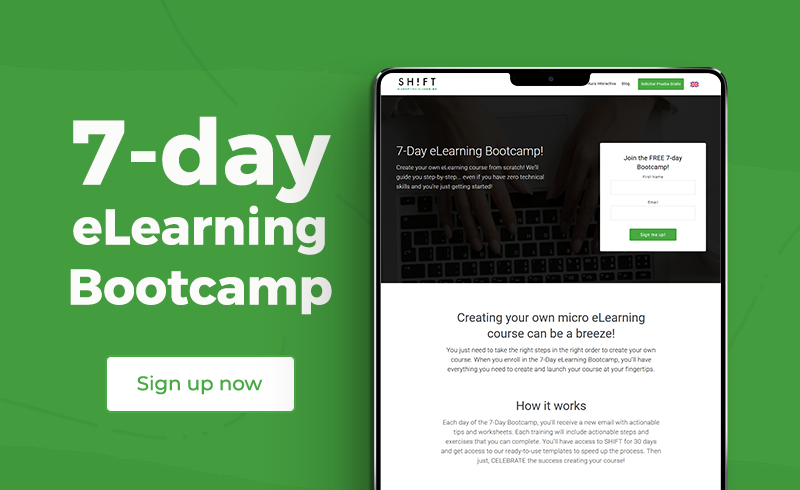How often have you groaned at the thought of attending yet another training session that you didn’t need? How often have you wondered “Why am I here” while going through an eLearning course and struggling not to doze off?
So if you are wondering whether they appreciate the training you make them go through, then make sure that you deliver it when your employees need it.
Here are the most common situations when you need to invest in training to make it worth the investment:

1) When They Need to Learn a New Skill
This is the most obvious scenario when you have to train your employees because the chances are that if it (processes, products, or equipment) is new, they do not know about it. You have to make them ready to embrace change. The following novel scenarios demand that you train your employees:
- The introduction of new technology, tools, or equipment: You may have to train both the internal users (your employees) and external users (vendors, third-party service providers, etc.)
- The introduction of new procedures or modification of the current ones: Both scenarios necessitate that you provide training to your employees.
The induction of new employees: New employees have to be trained in the specific concepts, policies, procedures, technologies, and know-how of a company to help perform their duties efficiently. Yet, companies are known to postpone these training sessions till the time they have several new hires that can be trained in a batch. This means that during the interim period, some new employees start working at their jobs with inadequate knowledge or skills. This is risky for a business. At other times, companies are compelled to arrange for (hurried) one-on-one training sessions, which are costly and can result in inconsistent messages being delivered.
Some helpful articles you might want to check out:
Yes, you can teach soft skills with e-Learning!
Best Practices for Using eLearning in Soft Skills Training
2) When Employees Lack of Basic Skills Or, Don't Know How to Apply Their Knowledge
These scenarios present evaluation deficiencies that prevent you from determining the worth of the employee and assign him/her a job that suits his/her skills. You need to provide training to your employees in the following cases:
When there is a lack of basic skills: This refers to the situation when employees lack basic skills like knowing how to use a program or a machine to do their job.
When there is a lack of application: Sometimes employees have the skills and the knowledge but don’t know how to apply these to carry out their jobs.
Investing in ongoing training for employee learning and development is a great way to close these skill gaps that tend to destroy business efficiencies while also boosting employee motivation to advance further in the company.
However, keep in mind that training cannot address performance issues of your employees if these stem from the following causes:
- Wrong recruitment or putting the wrong man on the job
- Flawed policies and procedures
- Inadequate support systems, lack of infrastructure, or other workplace issues that prevent an employee from performing optimally
- Lack of coaching
There are also many other scenarios where delivering training is not effective unless you solve an underlying problem. Read about these scenarios here.
Read:
- Four Signs That an Organization May be Facing a Skills Gap
- Bridging the Skills-Gap with Competency-Based Learning
- How to Identify and Close Skill Gaps at Work
3) When You Have to Address Skill Gaps within the Existing Workforce
It is not always easy to nail down the right people for a job from a maze of external applicants. But it is not rare to have within your organization talented employees who can be trained to take on additional responsibilities or learn the ropes of a higher position. This let’s you address a skill gap without waiting around for the perfect candidate to show up and then spend time and effort to make him learn your company’s work culture and HR policies, which an existing employee already knows.
Also read: The True Cost of Not Providing Employee Training
4) When You Have to Provide Specialized Customer Support
From time to time, your customers may want specialized services or new products. In such cases, you will want your customer-facing executives or sales personnel to learn the skills or stock up on the knowledge to serve customers better. Consider creating an eLearning course that your executives can access 24x7x365 to learn a new skill and practice it or an online module containing up-to-date information on a new product that you can deliver to the smart device of your sales personnel on the go.
5) When Your Company Needs to Raise the Bar on Performance
Changing market conditions, increased customer demands, and the emergence of new technologies may compel you to raise the performance standards for certain positions. In such instances, you have to provide training to your employees to bridge the skill and/or knowledge gap.
For example, enhancing quality standards or implementing a new customer service approach.
6) When Your Employees Have to Meet New Compliance Regulations
New legislations or policies and improved safety guidelines that have been put into place demand training your employees so that they can comply with the standards and your business does not risk lawsuits.
An eLearning program is the best way to address the above-mentioned training needs. It provides time- and cost-saving automation; lets employees access the learning whenever they need it, takes the learning to their workplaces where they need it the most, and enables you to deliver consistent messages.
An eLearning program works best in these situations.
Some interesting reads:
- How I would approach creating compliance e-learning by Clive Shepherd
- How Mobile Learning Tackles Compliance Training


